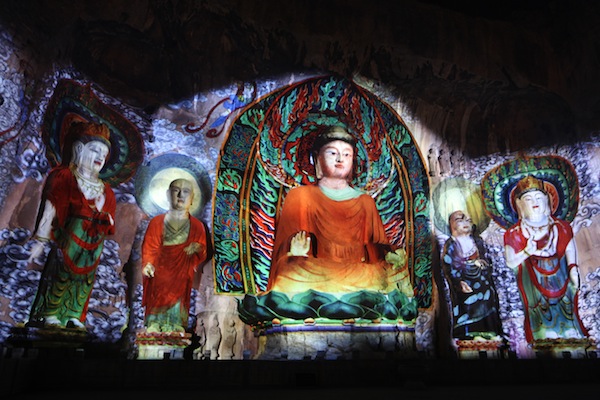- Christie and its partner, Wincomn Technology Development, have restored the essence of ancient art at Longmen Grottoes, one of China’s cave shrines carved with Buddhist sculptures that earned its recognition as a UNESCO heritage site.
- Christie projectors display multimedia contents representing the expressions of the Buddhas and other statues, using projection mapping on the uneven surfaces of the Fengxian Temple.
- Located 12 kilometers south of Luoyang, the Longmen Grottoes house tens of thousands of statues of Buddha and his disciples. More than 100,000 sculptures were painstakingly carved into 1400 caves excavated from the cliffs of the Xiangshan and Longmenshan mountains, running east and west of the Yi river. Dating to as early as the Northern Wei dynasty in 493 CE, the sculptures span many hundreds of years of artistic mastery representing a myriad of artistic styles from the simple and well-shaped carving of the Northern Wei dynasty to the more sophisticated artmanship, characterized by its delicate details, of the Tang dynasty.
- Since 1951, the Longmen Grottoes have undergone massive restoration works. From strengthening rock bases to arresting seepage of water from the roofs and sides of the grottoes, as well as clearing of overgrown vegetation and installing footpaths for easy access, the Chinese government is determined to preserve and promote the grottoes.
- In its latest effort at restoring the site, the grottoes management committee engaged Christie and Wincomn to add colors to its largest cave system of the Fengxian Temple. Dedicated to ancestor worship, the temple elevates 11 statues of Buddhas with the biggest statue of Vairocana Buddha standing at 17.14 meters tall, and with its head and ears measuring four meters and 1.9 meters respectively. These carvings represent the vigorous, elegant, and realistic style of the Tang dynasty.
- “Wincomn integrates modern projection technology and ancient Buddhist art to amplify the magnificence and mysterious beauty of the cave systems," projector manager, Wincomn, Zhiqiang Liu said. "Like its predecessors, Wincomn is heavily involved in the restoration of Fengxian Temple through the design of animation contents as well as the deployment of Christie projectors. The only difference between the work of our predecessors and ourselves is the application of modern technology, which makes what seems unachievable possible. Thanks to the advanced feature of Christie Twist, the multimedia contents are easily warped and edge-blended onto the uneven surfaces of the statues.”
- “Projection mapping is a technology that sees prevalent applications in making a still object lively using multimedia contents. Christie is honored to be awarded the important task of rejuvenating the Longmen Grottoes,” said vice president, Christie Asia Pacific, Lin Yu. “Due to natural and man-made ruin over more than 1500 years, the Longmen Grottoes have lost some of its radiance, making it a challenge to restore its grandeur, especially on the altered surfaces. However, our experience in restoring the grandeur of the ancient site of the Yungang Grottoes positioned us favorably to be chosen to help restore the historical, cultural and religious significance of the Longmen Grottoes. We hope it will immerse and mesmerize visitors in the lively art made possible through the projection mapping offered by Christie’s innovative visual technology.”
Christie Restores Buddhist Art at Longmen Grottoes with Projection Technology
